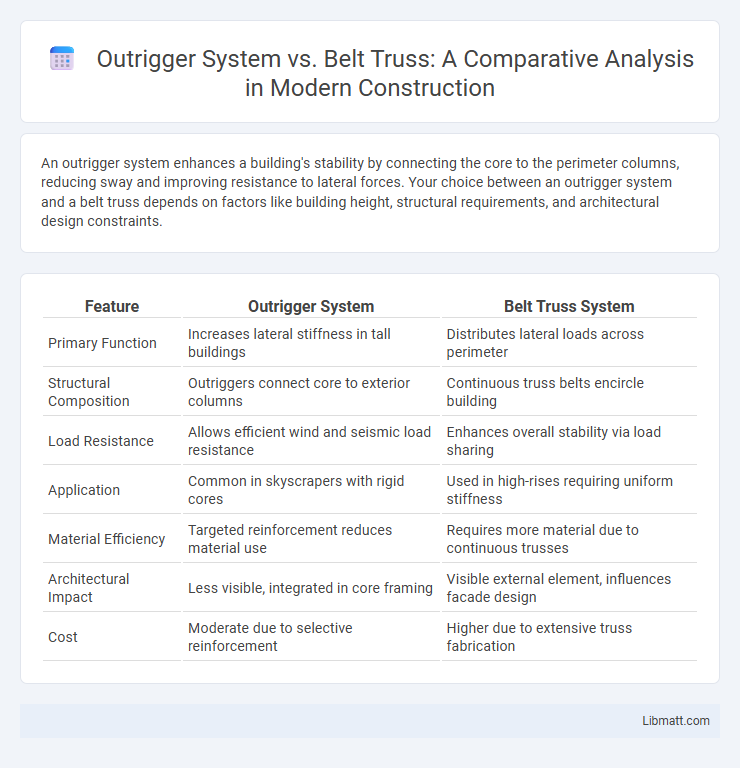An outrigger system enhances a building's stability by connecting the core to the perimeter columns, reducing sway and improving resistance to lateral forces. Your choice between an outrigger system and a belt truss depends on factors like building height, structural requirements, and architectural design constraints.
Table of Comparison
| Feature | Outrigger System | Belt Truss System |
|---|---|---|
| Primary Function | Increases lateral stiffness in tall buildings | Distributes lateral loads across perimeter |
| Structural Composition | Outriggers connect core to exterior columns | Continuous truss belts encircle building |
| Load Resistance | Allows efficient wind and seismic load resistance | Enhances overall stability via load sharing |
| Application | Common in skyscrapers with rigid cores | Used in high-rises requiring uniform stiffness |
| Material Efficiency | Targeted reinforcement reduces material use | Requires more material due to continuous trusses |
| Architectural Impact | Less visible, integrated in core framing | Visible external element, influences facade design |
| Cost | Moderate due to selective reinforcement | Higher due to extensive truss fabrication |
Introduction to Outrigger Systems and Belt Truss
Outrigger systems enhance structural stability by connecting the building core to exterior columns, reducing lateral sway and improving load distribution in high-rise buildings. Belt trusses, typically located at mechanical floors, encircle the building to provide additional rigidity and resist wind and seismic forces. Your choice between an outrigger system and a belt truss depends on factors like building height, architectural design, and structural load requirements.
Structural Principles of Outrigger Systems
Outrigger systems enhance building stability by connecting the core to perimeter columns through stiff horizontal structures, which redistribute lateral loads efficiently. This structural principle increases the building's moment of inertia, significantly reducing sway and drift under wind or seismic forces. Your skyscraper design benefits from improved stiffness and load resistance without excessively increasing core size or material use.
Structural Principles of Belt Truss
The structural principle of a belt truss involves encircling a high-rise building's perimeter with a stiff horizontal truss system that connects and stabilizes the vertical columns, effectively distributing lateral loads such as wind or seismic forces. This truss belt works in conjunction with outriggers, which extend from the building core to the perimeter columns, enhancing the stiffness and reducing lateral drift by transferring moments from the core to the perimeter frame. By integrating the belt truss, the building's overall structural system gains increased rigidity and strength, allowing for more efficient use of materials and improved resistance to bending and torsion.
Key Differences: Outrigger vs Belt Truss
The key differences between outrigger systems and belt trusses lie in their structural functions and placement; outriggers connect the building core to exterior columns to enhance lateral stiffness, while belt trusses encircle the building perimeter, redistributing loads and stabilizing floor diaphragms. Outrigger systems typically consist of stiff horizontal beams linked to core walls, significantly improving resistance to wind and seismic forces by integrating external columns. Belt trusses provide continuous support around the facade, limiting lateral displacement by tying outer columns together, often used in tall buildings to manage overturning moments effectively.
Advantages of Outrigger Systems
Outrigger systems enhance building stability by effectively transferring lateral loads to the core, reducing sway and improving occupant comfort in high-rise structures. They enable taller buildings with slimmer profiles by distributing forces more efficiently than traditional belt truss systems, resulting in material savings and architectural flexibility. Your design benefits from increased structural stiffness and reduced lateral drift, making outrigger systems a preferred choice for modern skyscraper engineering.
Advantages of Belt Truss Systems
Belt truss systems offer superior lateral load resistance by effectively distributing wind and seismic forces across the structure, enhancing overall stability in high-rise buildings. Their integration with perimeter columns reduces structural sway and improves occupant comfort while optimizing material usage. This system also allows for more flexible interior layouts by minimizing the need for internal bracing, maximizing usable floor space.
Application Scenarios for Each System
Outrigger systems are primarily applied in high-rise buildings where lateral stiffness and reduced sway are critical, effectively connecting the core to perimeter columns to enhance structural stability. Belt trusses are favored in buildings with long spans or irregular shapes, providing lateral support by tying exterior columns together at one or multiple levels to distribute loads evenly. Both systems address wind and seismic forces but are chosen based on architectural constraints and load distribution requirements specific to each project's design.
Design Considerations and Challenges
Outrigger systems enhance building stability by connecting the core to perimeter columns, distributing lateral loads efficiently, but require precise alignment and integration with structural elements to avoid stress concentrations. Belt trusses encircle the building's exterior, providing continuous support and stiffness but involve complex joint detailing and increased material usage, which can impact construction costs and timelines. Your choice between these systems must balance architectural constraints, structural performance, and constructability challenges to optimize overall building resilience.
Cost Comparison and Construction Efficiency
Outrigger systems generally involve higher initial costs due to complex structural components and installation requirements, while belt trusses offer a more cost-effective solution with simpler fabrication and erection processes. Construction efficiency is enhanced with belt trusses as their modular design reduces on-site labor time and coordination challenges, whereas outrigger systems require precise alignment and specialized expertise, potentially extending project timelines. Your choice depends on balancing budget constraints with project complexity and long-term structural performance needs.
Conclusion: Choosing the Right Structural System
Selecting the appropriate structural system depends on project requirements such as building height, lateral load resistance, and economic factors. The outrigger system excels in enhancing stiffness for supertall buildings by connecting core and perimeter columns, while the belt truss system provides efficient load distribution in medium to high-rise structures. Evaluating design complexity, cost, and architectural flexibility guides optimal decision-making between these two structural solutions.
Outrigger system vs belt truss Infographic

 libmatt.com
libmatt.com